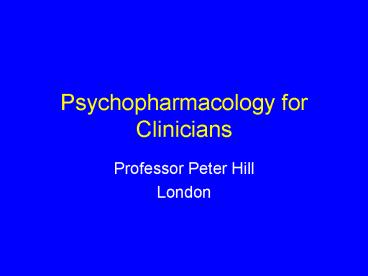Psychopharmacology for Clinicians - PowerPoint PPT Presentation
1 / 31
Title:
Psychopharmacology for Clinicians
Description:
can add evening clonidine (ECG first), melatonin, sedative antihistamine ... monitor BP, pulse rate (and ECG?) warn parents not to stop abruptly ... – PowerPoint PPT presentation
Number of Views:116
Avg rating:3.0/5.0
Title: Psychopharmacology for Clinicians
1
Psychopharmacology for Clinicians
- Professor Peter Hill
- London
2
General principles
- Use drugs as part of overall plan
- Consider symptoms rather than disorders
- Consult widely the published evidence is often
weak - Titrate doses rather than mg/kg
- Be aware most drugs are not licensed
3
Titration
- Children have very effective livers much of an
oral dose is lost on first pass metabolism - Be clear about goals. Dont be satisfied with
just some improvement - Find a way of measuring improvement, possibly a
rating scale
4
School
- Best if fully involved
- Need information. Problem getting all teachers in
secondary/high schools involved - Stimulants need only be given on schooldays
5
Drugs to know
- methylphenidate/dexamphetamine
- atomoxetine
- SSRIs
- imipramine
- clonidine
- sedative antihistamines
- benzodiazepines
6
Drugs to be aware of
- clomipramine
- propanolol
- risperidone
- other antipsychotics
- mood stabilisers
7
Methylphenidate (MPH)
- Stimulates many mental functions by blocking
dopamine transporter - (i.e.re-uptake blockade at synapse)
8
At the (midbrain) synapse
presynaptic
postsynaptic
dopamine
D4 receptor
dopamine transporter recovers DA to presynaptic
neurone
9
At the synapse
Excess dopamine transporter in about half of all
cases Dougherty et al. 1999
10
At the synapse
Excess dopamine transporter in about half of all
cases Dougherty et al. 1999
11
Methylphenidate (MPH)
- Stimulates many mental functions by blocking
dopamine transporter (i.e.re-uptake blockade at
synapse) - Can do this in normal children (abuse by
parents?) - Not addictive in ADHD treatment
- Sustained release preparations popular (school
not involved - not a good thing?)
12
Methylphenidate (MPH)
- Onset insomnia
- do not give too late in the day
- problems with evening behaviour/homework
- can add evening clonidine (ECG first), melatonin,
sedative antihistamine - Growth problems infrequent with immediate release
(Ritalin, Equasym), unknown frequency with
sustained release preparations (Concerta XL,
Equasym XL)
13
Methylphenidate (MPH)
- Titration
- Can start with am dose, contrast am vs pm
- Otherwise aim for 3-3.5 hr intervals
- 5,5,5 (2.5) (8.00, 11.30, 3.00, (5.00)
- 10,10,5/10
- 15, 15, 15 (5-10)
- Or Concerta XL 18 then 36 etc.
- or Equasym XL?
14
Dexamphetamine
- very slightly longer duration than MPH
- adverse effects generally trickier to handle
- euphoria and misuse more of a problem
- dose is half that for MPH
(5mg10 mg MPH) - Adderall (dexamphetamine salts) is essentially
the same
15
Atomoxetine
- non-stimulant (?) ADHD treatment
- blocks norepinephrine transporter, especially in
frontal lobes - no insomnia though some reduced weight gain with
growth in first 12 months of use - likely to be non-controlled
16
Selective serotonin re-uptake inhibitors (SSRIs)
- fluoxetine
- sertraline
- paroxetine
- citalopram
- escitalopram
- fluvoxamine
17
Selective serotonin re-uptake inhibitors (SSRIs)
- differ from each other mainly in adverse effects
- helpful in depression, anxiety, obsessive
compulsive symptoms - may help self-injurious behaviour in severe
learning disability and autism - a few children become silly and socially
disinhibited - muddle over MHRA proscription
18
Imipramine
- useless antidepressant
- outclassed by desmopressin in enuresis
- not much good with anxiety
- moderately effective in ADHD
19
Clonidine
- moderately useful in ADHD, especially
hyperactivity and hostility, can use in evening - first line in Tourettes disorder (but often
ineffective) - post-traumatic stress disorder
- self-injurious behaviour in autism
- sleep problems (though can produce insomnia and
nightmares in a few)
20
Clonidine
- is a noradrenergic agonist at ?2 receptors
- ?2 receptors mainly in
- locus coeruleus (main NA centre in brainstem with
widespread activating projections to cortex) - prefrontal cortex
21
Pre-synaptic and post-synaptic a2 receptors
NA feedback
clonidine
22
Presynaptic NA agonism (locus coeruleus)inhibits
NA release by activating autoreceptor
NA feedback
clonidine
23
Postsynaptic NA agonism (pre-frontal cortex)
activates by simulating NA release
clonidine
24
Clonidine
- start low, go slow
- monitor BP, pulse rate (and ECG?)
- warn parents not to stop abruptly
- drowsiness main problem, wears off after 10 days
until ceiling at about 200-300 mcg daily
25
Sedative antihistamines
- widely used for sleep onset problems
(diphenhydramine, promethazine,
hydroxyzine,alimemazine/trimeprazine) - unlikely to help child with anger or anxiety
symptoms
26
Benzodiazepines
- rapid tranquillisation (lorazepam)
- panic attacks (alprazolam)
- may cause paradoxical excitement or dysphoria
- best used for brief periods only
27
Clomipramine
- tricyclic antidepressant with serotonin re-uptake
blocking action - powerful in OCD
- difficulty with adverse effects
- constipation
- dry mouth
- blurred vision
- postural hypotension
28
Risperidone
- reduces aggressive behaviour and rage
- reduces tics
- looks useful in ADHD symptoms in PDDs
- relatively low risk of extra-pyramidal effects
but a few dribble - weight gain a problem
29
Other antipsychotics
- haloperidol for tranquillisation and tics
- phenothiazines (chlorpromazine etc) for
short-term tranquillisation, otherwise best
avoided because of extra-pyramidal complications - olanzapine increasingly popular but weight gain
and sugar/fatty acid problems
30
Mood stabilisers
- mainly carbamazepine, valproate
- lithium less commonly because of
- thyroid and renal problems
- blood level monitoring needed
31
Future?
- more use of medication in child mental health
problems - more children with mental health problems that
specialist child psychiatric services can manage - non-specialists likely to be come involved as
prescribers





![[PDF] DOWNLOAD Handbook of Clinical Psychopharmacology for T PowerPoint PPT Presentation](https://s3.amazonaws.com/images.powershow.com/10085282.th0.jpg?_=202407250411)

























